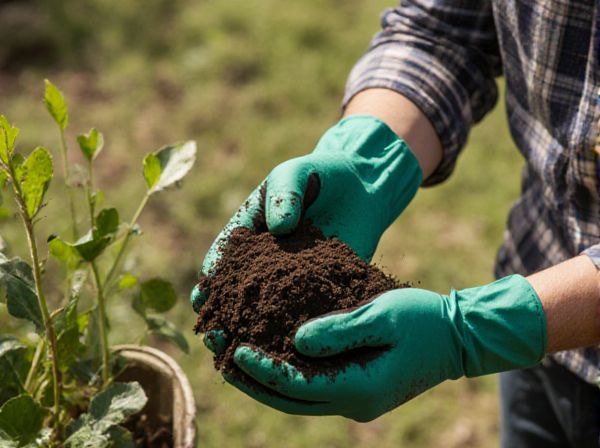
Soil pH vs Soil salinity Illustration
Soil pH measures the acidity or alkalinity of the soil, influencing nutrient availability and microbial activity. Soil salinity refers to the concentration of soluble salts in the soil, which can hinder plant growth by causing osmotic stress and nutrient imbalance. Managing both soil pH and salinity is crucial for optimizing soil health and crop productivity.
Table of Comparison
| Aspect | Soil pH | Soil Salinity |
|---|---|---|
| Definition | Measures acidity or alkalinity of soil | Concentration of soluble salts in soil |
| Measurement Unit | pH scale (0-14) | Electrical Conductivity (dS/m) or mg/kg |
| Optimal Range for Crops | 6.0 - 7.5 | < 2 dS/m |
| Impact on Plants | Influences nutrient availability and microbial activity | Causes osmotic stress, nutrient imbalance, and toxicity |
| Common Causes | Parent material, rainfall, fertilizer use | Irrigation with saline water, poor drainage |
| Correction Methods | Lime application to raise pH, sulfur to lower pH | Leaching salts with good drainage, gypsum application |
Understanding Soil pH: Basics and Importance
Soil pH measures the acidity or alkalinity of the soil, directly impacting nutrient availability and microbial activity essential for plant growth. Optimal soil pH typically ranges from 6.0 to 7.5, allowing maximum nutrient solubility and biological function. Understanding soil pH helps manage soil salinity effects, as high salinity often correlates with altered pH levels that can inhibit crop productivity.
Defining Soil Salinity and Its Effects
Soil salinity refers to the concentration of soluble salts like sodium chloride, calcium sulfate, and magnesium sulfate within the soil profile, directly impacting soil structure and plant health. High soil salinity creates osmotic stress, reducing water availability to plants and causing nutrient imbalances that inhibit growth. Unlike soil pH, which measures acidity or alkalinity, soil salinity specifically affects soil electrical conductivity and can lead to toxic ion accumulation detrimental to crop productivity.
Key Differences Between Soil pH and Soil Salinity
Soil pH measures the acidity or alkalinity level of the soil on a scale from 0 to 14, influencing nutrient availability and microbial activity, while soil salinity quantifies the concentration of soluble salts, affecting water uptake and plant growth. High soil pH often leads to nutrient deficiencies such as iron and manganese, whereas high soil salinity causes osmotic stress and ion toxicity in plants. Management techniques differ significantly: pH adjustments typically involve lime or sulfur application, whereas salinity control requires improved drainage and salt leaching strategies.
How Soil pH Influences Plant Growth
Soil pH significantly influences plant growth by affecting nutrient availability and microbial activity in the soil. Optimal pH levels, typically between 6 and 7, enhance the solubility of essential nutrients like nitrogen, phosphorus, and potassium, promoting healthy root development. In contrast, extreme pH values can lead to nutrient deficiencies or toxicities, impeding plant growth despite soil salinity levels.
The Impact of Soil Salinity on Crop Health
Soil salinity directly affects crop health by disrupting nutrient uptake and impairing water absorption, leading to stunted growth and reduced yields. High salinity levels increase osmotic stress, causing physiological drought even when soil moisture is adequate. Managing soil pH alone is insufficient, as saline soils require targeted leaching and salt-tolerant crop varieties to mitigate the adverse effects on plant development.
Measuring Soil pH: Methods and Tools
Measuring soil pH involves using pH meters, colorimetric test kits, and litmus paper, which accurately determine the acidity or alkalinity of soil samples essential for crop health. Soil pH influences nutrient availability and microbial activity, while soil salinity, measured by electrical conductivity meters, affects plant water uptake and growth. Regular monitoring with these tools helps optimize soil conditions for sustainable agriculture and crop productivity.
Assessing Soil Salinity: Practical Techniques
Assessing soil salinity involves measuring the electrical conductivity (EC) of a soil extract, with a saturated paste extract being the most reliable method for accuracy. Soil pH provides insight into the acidity or alkalinity but does not directly quantify salinity levels, which are critical for determining salt stress on crops. Portable EC meters and soil test kits offer practical, field-friendly solutions for monitoring salinity and managing soil health effectively.
Managing and Adjusting Soil pH Levels
Managing soil pH levels involves regular testing and the application of amendments such as lime to raise pH or sulfur to lower pH, optimizing nutrient availability and microbial activity. Soil salinity influences pH management strategies because high salinity can exacerbate nutrient imbalances and reduce amendment effectiveness. Implementing proper irrigation practices and selecting salt-tolerant crop varieties help mitigate salinity issues while maintaining ideal pH conditions for healthy plant growth.
Strategies for Reducing Soil Salinity
Effective strategies for reducing soil salinity include improving drainage systems to prevent salt accumulation and applying gypsum to replace sodium ions with calcium, enhancing soil structure. Incorporating organic matter promotes microbial activity that aids in salt leaching, while selecting salt-tolerant crops reduces the impact of saline conditions on yield. Regular soil testing helps monitor pH and salinity levels, enabling timely interventions to maintain optimal soil health for sustainable agriculture.
Choosing Plants Suitable for Specific pH and Salinity Levels
Selecting plants based on soil pH and salinity is essential for optimal growth, as different species have specific tolerance ranges; for instance, blueberries thrive in acidic soils with low salinity, while salt-tolerant plants like mangroves can survive high salinity and neutral to alkaline pH levels. Soil pH affects nutrient availability, influencing plant health, whereas soil salinity primarily impacts water uptake and root function. Matching plant species to the exact pH and salinity conditions of the soil enhances yield, disease resistance, and overall ecosystem sustainability.
Soil pH vs Soil salinity Infographic

 gardendif.com
gardendif.com